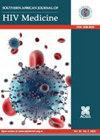三级抗逆转录病毒诊所蛋白酶抑制剂患者的疗效和特征
IF 2.3
4区 医学
Q4 INFECTIOUS DISEASES
引用次数: 0
摘要
背景:二十年来,蛋白酶抑制剂一直被世界卫生组织推荐为中低收入国家的二线抗逆转录病毒疗法(ART)。随着以多鲁替拉韦为基础的治疗方案的广泛应用,蛋白酶抑制剂的未来作用尚不确定:目的:描述在一家三级抗逆转录病毒疗法诊所接受以 PI 为基础的抗逆转录病毒疗法(一线和二线疗法)、双加强蛋白酶抑制剂(DBPI)以及在二线疗法中接受再循环核苷类逆转录酶抑制剂(NRTI)的患者的特征:我们对 2021 年 1 月至 2022 年 4 月期间在南非索韦托克里斯-哈尼-巴拉夸那思学术医院 Nthabiseng 成人传染病诊所就诊的接受 PI 抗逆转录病毒疗法的成人患者进行了描述性回顾性记录审查:在抽样的 900 名患者中,543 人(60.3%)为女性,年龄中位数为 45 岁,703 人(79.1%)的病毒载量(VL)低于 1000 拷贝/毫升。相比之下,36 名垂直感染患者中有 21 人(58.3%)的 VL 低于 1000 拷贝/毫升。37名(4.1%)患者正在使用DBPIs。24例(64.9%)患者使用DBPI的最常见原因是病毒学失败后在耐药性测试(DRT)指导下转用。49名(5.4%)患者使用的是回收的NRTI,没有进行DRT,24名(2.6%)患者使用的是有耐药性记录的NRTI。这些患者的治疗结果与总样本相似:PIs 长期以来一直是二线抗逆转录病毒疗法的基石。结论:PIs 长期以来一直是二线抗逆转录病毒疗法的基石,这项研究表明了 PIs 在现实世界中的实用性及其缺点。在二线治疗方案中循环使用 NRTIs 的患者的疗效没有差异。本文章由计算机程序翻译,如有差异,请以英文原文为准。
Outcomes and characteristics of patients on protease inhibitors at a tertiary level antiretroviral clinic
Background: Protease inhibitors (PIs) have been recommended as World Health Organization second-line antiretroviral therapy (ART) for low- to middle-income countries for two decades. As dolutegravir-based regimens have become widely available, the future role of PIs is uncertain.Objectives: To describe the characteristics of patients on PI-based ART (in first-line and second-line regimens), double-boosted protease inhibitors (DBPI) and patients who received recycled nucleoside reverse transcriptase inhibitors (NRTI) in second-line regimens at a tertiary level ART clinic.Method: We conducted a descriptive retrospective record review of adult patients on PI-based ART who attended Nthabiseng Adult Infectious Diseases Clinic at Chris Hani Baragwanath Academic Hospital in Soweto, South Africa, between January 2021 and April 2022.Results: Of the 900 patients sampled, 543 (60.3%) were female, the median age was 45 and 703 (79.1%) had viral loads (VL) below 1000 copies/mL. In contrast, 21 (58.3%) of 36 vertically infected patients had VLs below 1000 copies/mL. Thirty-seven (4.1%) patients were on DBPIs. The commonest reason for DBPI use in 24 (64.9%) patients was drug resistance test (DRT)-guided switch after virological failure. Forty-nine (5.4%) patients were on recycled NRTIs with no DRT, and 24 (2.6%) patients were on NRTIs to which there was documented resistance. Outcomes for these patients were similar to the total sample.Conclusion: PIs have long been a cornerstone of second-line ART. This study demonstrates the real-world utility of PIs, as well as their disadvantages. There was no difference in the outcomes of patients who received recycled NRTIs in second-line regimens.
求助全文
通过发布文献求助,成功后即可免费获取论文全文。
去求助
来源期刊
CiteScore
2.80
自引率
11.80%
发文量
41
审稿时长
>12 weeks
期刊介绍:
The Southern African Journal of HIV Medicine is focused on HIV/AIDS treatment, prevention and related topics relevant to clinical and public health practice. The purpose of the journal is to disseminate original research results and to support high-level learning related to HIV Medicine. It publishes original research articles, editorials, case reports/case series, reviews of state-of-the-art clinical practice, and correspondence.

 求助内容:
求助内容: 应助结果提醒方式:
应助结果提醒方式:


